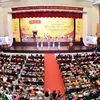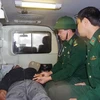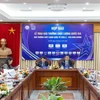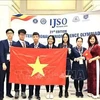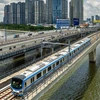Le Hoang Quan, a member of the Party Central Committee and Chairman of the Ho Chi Minh City People's Committee, told Vietnam News Agency about the city's goals and socio-economic achievements.
Q: Can you describe HCM City's socio-economic and cultural achievements since 1975?
A: During the past four decades HCM City has achieved major development in many areas. The city's economy has grown several folds and infrastructure has developed significantly compared with four decades ago.
The city overcame a very difficult period in the first decade (1975-1985) after its liberation. The city was able to sustain production even as the country was threatened by a border war.
Thirty years later, after the sixth National Congress of the Communist Party of Vietnam was held in 1986, HCM City continued to sustain its economic development and share its practical experience in innovating administrative mechanisms with the Party and Government.
The Communist Party's policy in switching to a socialist-oriented market economy from a centrally planned one helped stimulate production and unleash the economy. The private and foreign sectors have been developing speedily and become an important channel for investments.
The relationship between HCM City and other countries has been broadening. Vietnam's WTO membership and the city administration's efforts have helped the city integrate deeply with the world.
Q: Can you tell us about the city's major achievements in social welfare?
A: With global integration, the spiritual and material living conditions of the city's people have improved along with the speedy development of infrastructure by the city administration.
At present, the city's income per capita is 5,131 USD. It is estimated that the income per capita will reach 5,538 USD by the end of this year. This is a big leap compared with 1,011 USD in 2000 and 360 USD in 1976.
In 2014 the city accounted for 20 percent of the country's GDP. The city also contributed 30 percent of the Government's revenues and exports.
The city has successfully provided universal secondary education. The city now has nearly 1,500 schools with 1.3 million students and 65,000 teachers.
Municipal healthcare has also been expanded. By the end of last year the city had 105 hospitals with a total of 34,000 beds, providing healthcare for 29 million people with 14.5 doctors and 43 beds for every 10,000 people.
Q: Can you describe some key challenges facing the city's socio-economic and cultural development?
A: The city has confronted a number of critical issues and shortcomings, including slow transformation of economic structure, modest growth quality and low competitiveness.
It also encounters serious problems experienced by rapidly developing and highly populated cities such as inadequate urban planning and management, overloaded infrastructure, shortage of quality human resources, worsening traffic congestion and environmental pollution, among others.
Q: Can you tell us more about the city's development plan for until 2020? What are the main targets the city has to achieve in the period?
A: Based on the city's socio-economic achievements in the 40 years since the liberation of South Vietnam for the country's reunification, the city has some important general and specific targets for the period between 2020 and 2025.
With regard to the general targets, HCM City will become a civilised, modern city and a special urban area that will be in the vanguard of industrialisation and modernisation and contribute to the socio-economic development of the southern region and country. It will also be an economic, financial, trade, and science and technology hub of the country and Southeast Asia.
By 2020 HCM City is expected to become a centre of culture and sport and a place training quality human resources for the southern region and the country, contributing to sustainable economic development, environmental protection and security.
As for the specific targets, the HCM City government expects annual economic growth of between 9.5 and 10 percent between 2016 and 2020. And the city's annual growth rate between 2021 and 2025 is expected to be 8.5 to 9 percent.
The city's population should be 8.3 million in 2015, 9.2 million in 2020 and 10 million in 2025, excluding migrants.
From 2015 every year the city will create 120,000 jobs. From 2020 there will be 125,000 new jobs every year, and the figure will be 130,000 after 2025.
The unemployment rate will be limited to below 4 percent from 2020. And the city plans to have no households living below the poverty line of 16 million VND (769 USD) per person/year.
The city will also focus on breakthroughs in infrastructure development, strengthening the quality and effectiveness of urban zoning and urban management.-VNA
Q: Can you describe HCM City's socio-economic and cultural achievements since 1975?
A: During the past four decades HCM City has achieved major development in many areas. The city's economy has grown several folds and infrastructure has developed significantly compared with four decades ago.
The city overcame a very difficult period in the first decade (1975-1985) after its liberation. The city was able to sustain production even as the country was threatened by a border war.
Thirty years later, after the sixth National Congress of the Communist Party of Vietnam was held in 1986, HCM City continued to sustain its economic development and share its practical experience in innovating administrative mechanisms with the Party and Government.
The Communist Party's policy in switching to a socialist-oriented market economy from a centrally planned one helped stimulate production and unleash the economy. The private and foreign sectors have been developing speedily and become an important channel for investments.
The relationship between HCM City and other countries has been broadening. Vietnam's WTO membership and the city administration's efforts have helped the city integrate deeply with the world.
Q: Can you tell us about the city's major achievements in social welfare?
A: With global integration, the spiritual and material living conditions of the city's people have improved along with the speedy development of infrastructure by the city administration.
At present, the city's income per capita is 5,131 USD. It is estimated that the income per capita will reach 5,538 USD by the end of this year. This is a big leap compared with 1,011 USD in 2000 and 360 USD in 1976.
In 2014 the city accounted for 20 percent of the country's GDP. The city also contributed 30 percent of the Government's revenues and exports.
The city has successfully provided universal secondary education. The city now has nearly 1,500 schools with 1.3 million students and 65,000 teachers.
Municipal healthcare has also been expanded. By the end of last year the city had 105 hospitals with a total of 34,000 beds, providing healthcare for 29 million people with 14.5 doctors and 43 beds for every 10,000 people.
Q: Can you describe some key challenges facing the city's socio-economic and cultural development?
A: The city has confronted a number of critical issues and shortcomings, including slow transformation of economic structure, modest growth quality and low competitiveness.
It also encounters serious problems experienced by rapidly developing and highly populated cities such as inadequate urban planning and management, overloaded infrastructure, shortage of quality human resources, worsening traffic congestion and environmental pollution, among others.
Q: Can you tell us more about the city's development plan for until 2020? What are the main targets the city has to achieve in the period?
A: Based on the city's socio-economic achievements in the 40 years since the liberation of South Vietnam for the country's reunification, the city has some important general and specific targets for the period between 2020 and 2025.
With regard to the general targets, HCM City will become a civilised, modern city and a special urban area that will be in the vanguard of industrialisation and modernisation and contribute to the socio-economic development of the southern region and country. It will also be an economic, financial, trade, and science and technology hub of the country and Southeast Asia.
By 2020 HCM City is expected to become a centre of culture and sport and a place training quality human resources for the southern region and the country, contributing to sustainable economic development, environmental protection and security.
As for the specific targets, the HCM City government expects annual economic growth of between 9.5 and 10 percent between 2016 and 2020. And the city's annual growth rate between 2021 and 2025 is expected to be 8.5 to 9 percent.
The city's population should be 8.3 million in 2015, 9.2 million in 2020 and 10 million in 2025, excluding migrants.
From 2015 every year the city will create 120,000 jobs. From 2020 there will be 125,000 new jobs every year, and the figure will be 130,000 after 2025.
The unemployment rate will be limited to below 4 percent from 2020. And the city plans to have no households living below the poverty line of 16 million VND (769 USD) per person/year.
The city will also focus on breakthroughs in infrastructure development, strengthening the quality and effectiveness of urban zoning and urban management.-VNA









